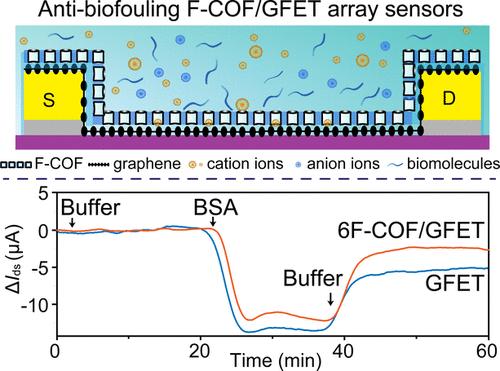氟化共价有机骨架膜改性石墨烯场效应晶体管生物传感器的尺寸依赖筛选和抗污垢效应
IF 9.1
1区 材料科学
Q1 CHEMISTRY, MULTIDISCIPLINARY
引用次数: 0
摘要
石墨烯场效应晶体管(gfet)有望实现无标签生物传感,但在复杂的生物流体中存在非特异性蛋白质吸附和选择性差的问题。在此,我们提出了一种表面工程策略,赋予GFET阵列防污稳健性和分子筛选选择性。在液-液界面合成的两种富氟共价有机框架(F-COF)薄膜通过温和的无溶剂层压协议转移到GFET通道上,形成具有高跨导性和典型石墨烯双极特性的F-COF/GFET传感器。改良的GFET传感器中的F-COF薄膜作为较小的金属离子(如二价阳离子,如Zn2+)的尺寸选择门,但排除阴离子甲基橙和较大阳离子罗丹明b。F-COF/GFET传感器减少了非特异性蛋白质的吸附,并允许在低浓度(10-6 M)下检测Ca2+,当暴露于含有10-4 M牛血清白蛋白的模拟生理环境中时。从单体水平的识别中解耦防污为生物流体中的选择性实时GFET生物传感器提供了一种通用策略。本文章由计算机程序翻译,如有差异,请以英文原文为准。

Fluorinated Covalent Organic Framework Films Modified Graphene Field-Effect Transistor Biosensors with Size-Dependent Sieving and Antibiofouling Effect
Graphene field-effect transistors (GFETs) promise label-free biosensing but suffer from nonspecific protein adsorption and poor selectivity in complex biofluids. Herein, we proposed a surface-engineering strategy to endow GFET arrays with antifouling robustness and molecular-sieving selectivity. Two fluorine-rich covalent organic framework (F-COF) films synthesized at the liquid–liquid interface were transferred onto GFET channels through a gentle, solvent-free lamination protocol, creating F-COF/GFET sensors with high transconductance and typical bipolar characteristics of graphene. F-COF films in the modified GFET sensors functioned as size-selective gates for smaller metal ions (e.g., divalent cations like Zn2+), but excluded anionic methyl orange and larger cationic Rhodamine B. The F-COF/GFET sensors reduced the nonspecific protein adsorption and allowed the detection of Ca2+ at low concentrations (10–6 M) when exposed to a simulated physiological milieu containing 10–4 M bovine serum albumin. Decoupling antifouling from recognition at the monomer level provides a generalizable strategy for selective, real-time GFET biosensors in biofluids.
求助全文
通过发布文献求助,成功后即可免费获取论文全文。
去求助
来源期刊

Nano Letters
工程技术-材料科学:综合
CiteScore
16.80
自引率
2.80%
发文量
1182
审稿时长
1.4 months
期刊介绍:
Nano Letters serves as a dynamic platform for promptly disseminating original results in fundamental, applied, and emerging research across all facets of nanoscience and nanotechnology. A pivotal criterion for inclusion within Nano Letters is the convergence of at least two different areas or disciplines, ensuring a rich interdisciplinary scope. The journal is dedicated to fostering exploration in diverse areas, including:
- Experimental and theoretical findings on physical, chemical, and biological phenomena at the nanoscale
- Synthesis, characterization, and processing of organic, inorganic, polymer, and hybrid nanomaterials through physical, chemical, and biological methodologies
- Modeling and simulation of synthetic, assembly, and interaction processes
- Realization of integrated nanostructures and nano-engineered devices exhibiting advanced performance
- Applications of nanoscale materials in living and environmental systems
Nano Letters is committed to advancing and showcasing groundbreaking research that intersects various domains, fostering innovation and collaboration in the ever-evolving field of nanoscience and nanotechnology.
 求助内容:
求助内容: 应助结果提醒方式:
应助结果提醒方式:


